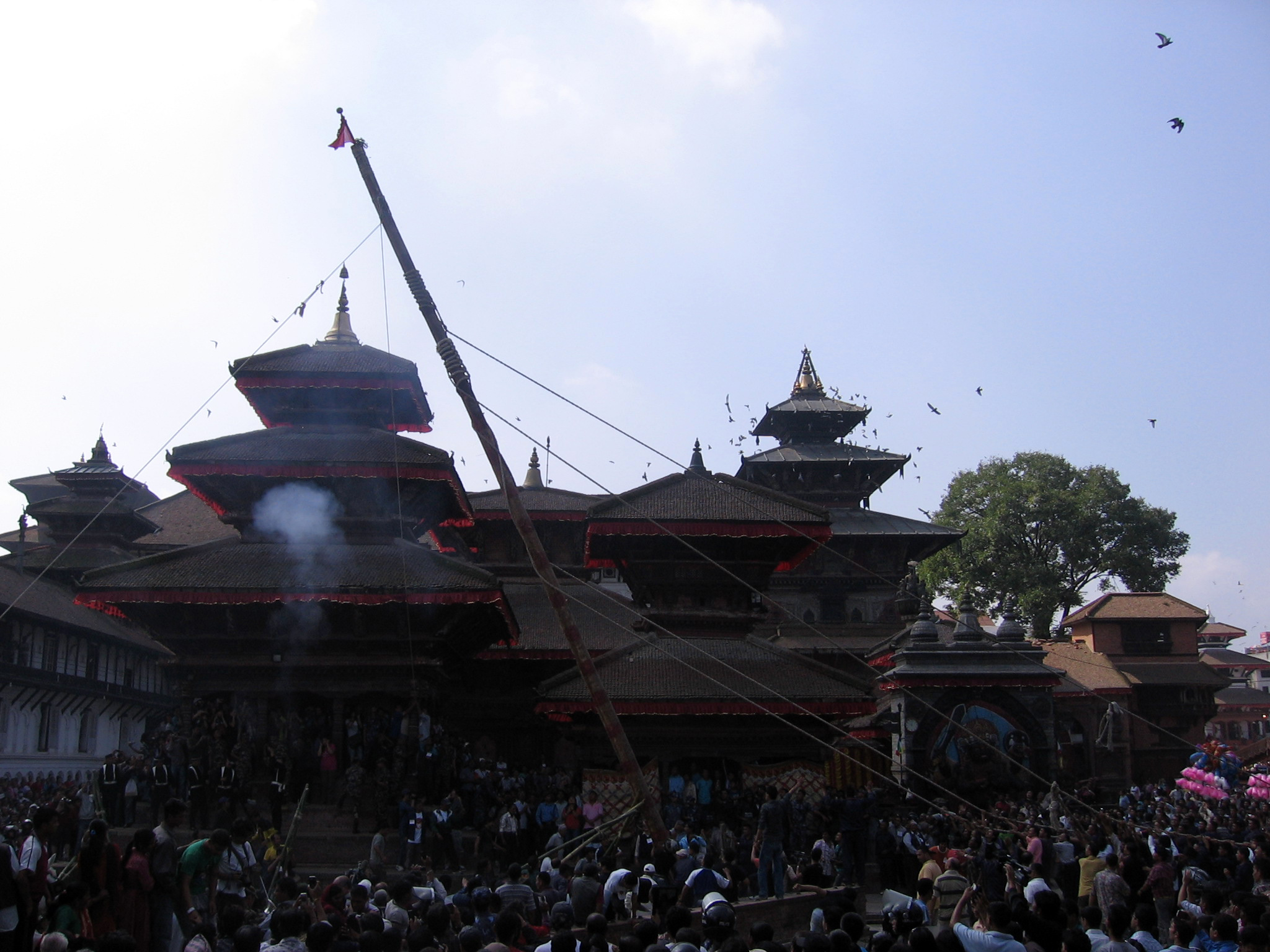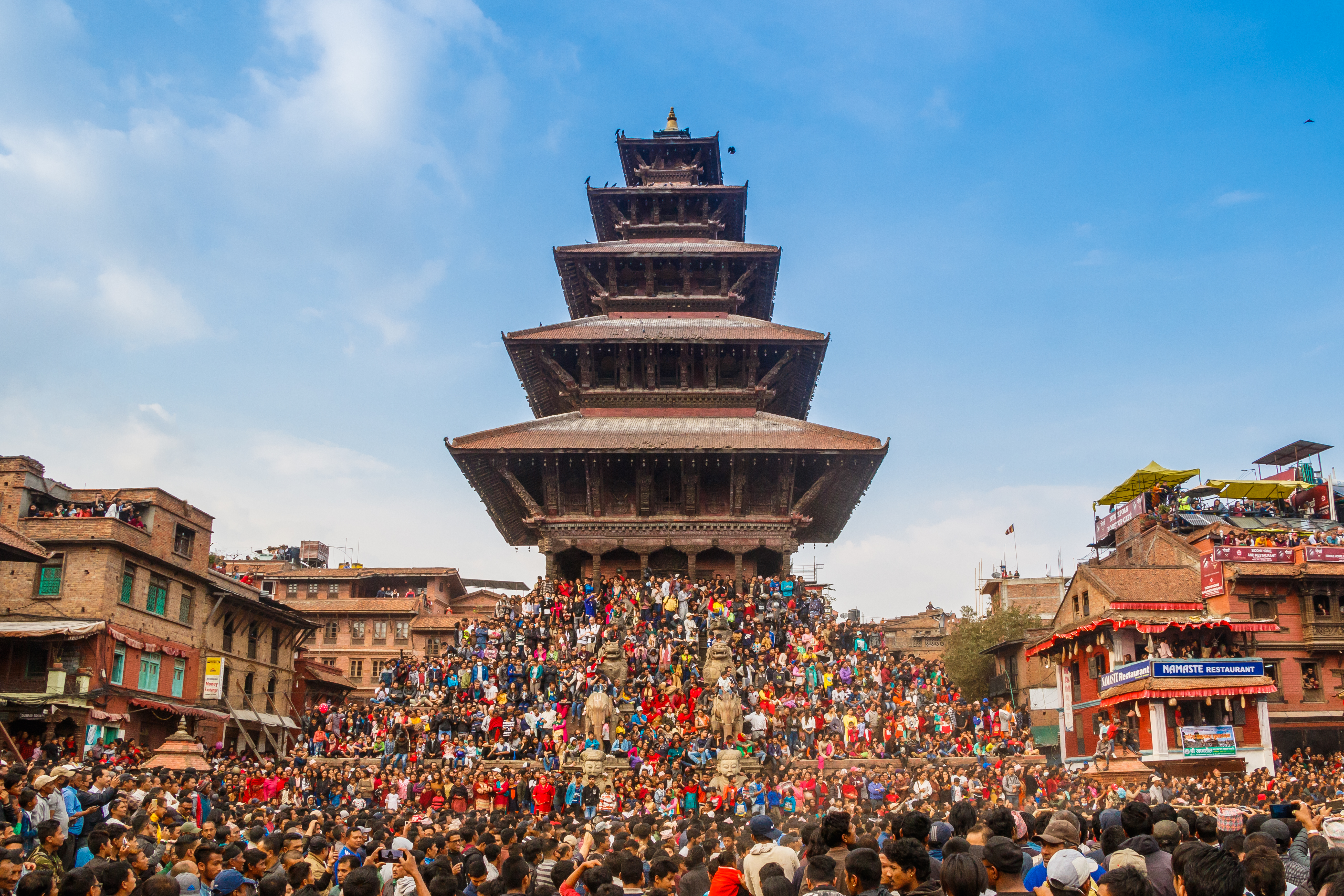|
Jatra (Nepal)
Jatra (Nepal Bhasa: 𑐖𑐵𑐟𑑂𑐬𑐵, जात्रा) refers to the types of Newa Festivals involving street festival or carnival.Lonely Planet Trekking in the Nepal Himalaya - Page 357 Bradley Mayhew, Joe Bindloss - 2009 "The people of Bhaktapur celebrate Bisket Jatra (Death of the Snake Demons Festival) on this day." Some jatras * Janmadya Jatra: Celebrated in central Kathmandu * Yenya (Indra Jatra) : Celebrated in central Kathmandu * Bungdya Jatra: Celebrated in Patan * Bisak Jatra: Celebrated in Major parts of Bhaktapur * Bisket Jatra: Celebrated in Bhaktapur, Dhapasi, Madhyapur Thimi, Tokha and other places in Nepal * Bhoto Jatra: Celebrated in Patan * Gai Jatra: Celebrated on the Kathmandu Valley * HaadiGaun Jatra: Celebrated in Hadigaun in Kathmandu * Khame Jatra:Celebrated on the Bhaktapur on the ninth day of Dasain * Shikali Jatra: Celebrated in Khokana, Lalitpur * Dolkhala Jatra: Celebrated in Dolkha * Dharmasthali Jatra: Celebrated in Dharmasthali in K ... [...More Info...] [...Related Items...] OR: [Wikipedia] [Google] [Baidu] |
Nepal Bhasa
Newar (), or Newari and known officially in Nepal as Nepal Bhasa, is a Sino-Tibetan language spoken by the Newar people, the indigenous inhabitants of Nepal Mandala, which consists of the Kathmandu Valley and surrounding regions in Nepal. "Nepal Bhasa" literally means "Nepalese language", however the language is not the same as Nepali (Devanāgarī: नेपाली), the country's current official language of the central government. The two languages belong to different language families (Sino-Tibetan and Indo-European, respectively), but centuries of contact have resulted in a significant body of shared vocabulary. Newar was Nepal's administrative language from the 14th to the late 18th century. From the early 20th century until democratisation, Newar suffered from official suppression. From 1952 to 1991, the percentage of Newar speakers in the Kathmandu Valley dropped from 75% to 44% and today Newar culture and language are under threat. The language has been l ... [...More Info...] [...Related Items...] OR: [Wikipedia] [Google] [Baidu] |
Newa Festival
The Newas are well known for their lavish festivals. The word jatra is used for carnivals. Based on Nepalese calendar, Nepal Sambat, the different festivals are: * Swanti * Sakimila Punhi * Yoma * Yomari Punhi * Ghayh * Swasthani * Shree Panchami * Sila Chahre * Holi Punhi * Pahan Charhe * Bisket Jatra * Jana Baha Dyah Jatra * Bungdya Jatra * Bhoto Jatra * Swanya Punhi * Sithi Nakhah * Gathan Mugah * Gunla * Gunhu Punhi * kuchhi bhoyey * * Pancha Dan * Yenya * Mohani Mohani or Mohni (Nepal Bhasa: ) is one of the most important festivals among the Newars which involves a packed itinerary of religious services, pilgrimages, family gatherings and outdoor celebrations lasting several days. Special dinners know ... * Mataya (Lalitpur) External links Jwajalapa {{Newar Newar ... [...More Info...] [...Related Items...] OR: [Wikipedia] [Google] [Baidu] |
Yenya
Indra Jātrā, also known as Yenyā (Nepal Bhasa: येँयाः), is the biggest religious street festival in Kathmandu, Nepal. The celebrations consist of two events, Indra Jātrā and Kumāri Jātrā. Indra Jātrā is marked by masked dances of deities and demons, displays of sacred images and tableaus in honor of the deity Indra, the king of heaven. Kumāri Jātrā is the chariot procession of the living goddess Kumari. Family members deceased in the past year are also remembered during the festival. The main venue of the festivities is Kathmandu Durbar Square. The celebrations last for eight days from the 12th day of the bright fortnight to the 4th day of the dark fortnight of Yanlā (ञला), the eleventh month in the lunar Nepal Era calendar. Indra Jatra was started by King Gunakamadeva- (गुणकामदेव) to commemorate the founding of the Kathmandu city in the 10th century. Kumari Jatra began in the mid-18th century. The celebrations are held acco ... [...More Info...] [...Related Items...] OR: [Wikipedia] [Google] [Baidu] |
Bisket Jatra
Biska Jatra, is an annual event in Bhaktapur, Dhapasi, Madhyapur Thimi and Tokha and other places in Nepal. The festival is celebrated at the start of the new year on the Bikram Sambat calendar, however, the festival itself is not related to Bikram Sambat. Origin Legend has it that this celebration is the "festival after the death of the serpent". Various areas of Bhaktapur city celebrate this festival according to their own rituals. The most eventful places are Taumadhi Square and Thimi Balkumari. A chariot carrying the statue of Lord Bhairava is pulled by hundreds of people to towards upper (''Thaney'') and lower (''Koney'') neighbourhood as tug of war. Approximately a month earlier, the chariot is assembled near the Nyatapola temple. Observations The signature event on Bhaktapur Taumadhi kicks off the Biska jatra "dya koha bijyaigu" which means the god Bhairava is brought outside from its temple for the festival, it is a tug-of-war between the Thane (upper) and Kone (low ... [...More Info...] [...Related Items...] OR: [Wikipedia] [Google] [Baidu] |
Gai Jatra
Gai Jatra (), also known by its endonym Sa Paru (Nepal Bhasa: ), is a Nepalese festival celebrated mainly in the Kathmandu valley by the Newar people. The festival is celebrated in honour of their immediate relatives who have died during the previous year. Various groups of children dressed up as cows and in other comedic drags are organized throughout various cities. It is generally celebrated in the month of Bhadra (August/September). The date is set according to the lunar Nepal Samabat calendar and falls on the first day of the dark fortnight of the month of Gunla. Origin Gai Jatra was started by King Pratap Malla during his reign from 1641 to 1671 AD. His teenage son Chakravartendra Malla died an untimely death and the queen grieved the loss of her son. King Pratap Malla started this tradition to both help ascend his son to the next life and also to cheer the grieving queen and families of those whose loved ones had passed away. Etymology The festival is known as Sa ... [...More Info...] [...Related Items...] OR: [Wikipedia] [Google] [Baidu] |
Khame Jatra
Khame Jatra or Kha Me Jatra is a festival celebrated in Bhaktapur, Nepal. It occurs in the ninth day of Dashain. It is mainly celebrated by the Newar people. A similar procession is also practised in Panauti, but it is in the form of ''Puja'' rather than a ''Jatra''. Preparation ''Kha Me'' means a pure male buffalo which does not have any physical wounds or defects. It must have seven ''chakras'' and its hair in the front and the middle parts should lean towards the front and the hair in back should lean towards the back. This buffalo is specially reared for the festival in the name of Bramhayani goddess by Banamala clan, a sub-group of Newar community. In case such buffalo cannot be found, a rope is tied as a symbol of Kha Me in the temple pillar. Main activity In Dasain, the buffalo is brought to Gathemung (Dattatreya square) near the temple of goddess Durga. On the evening of the ninth day of Dasain, it is taken to the open street and chased from the Durga temple towards Br ... [...More Info...] [...Related Items...] OR: [Wikipedia] [Google] [Baidu] |
Shikali Jatra
Shikali Jatra is a religious festival of Newar people in Khokana of the Kathmandu Valley. The jatra is performed in Dashain by the people who do not celebrate the Dashain festival. The Jatra is five days long and is dedicated to the goddess Shikali (also called ''Ajima Ajima (Nepal Bhasa:अजिमा) is a group of goddesses of the Newar pantheon. These goddesses are respected by all sects and castes of Newars, both from Hindu and Buddhist religion. If we look Ajimas from sky, they look like a sword. So, it ...''). The goddess Shikali is one of the sisters of goddess in Dakshinkali. The Shikali's temple is located in Khokana. In Khokana there are three major communities namely Tagu, Salagu and Jagu. On the day of Jatra, four virgin boys each from Tagu and Salagu is selected to worship Shikali. The locals wears masks to represent 14 Hindu gods and goddesses. Masked dances is performed following tantric rituals. The dancers wears colourful attires. A wooden chariot of goddess ... [...More Info...] [...Related Items...] OR: [Wikipedia] [Google] [Baidu] |
Newar
Newar (; new, नेवार, endonym: Newa; new, नेवा, Pracalit script:) or Nepami, are the historical inhabitants of the Kathmandu Valley and its surrounding areas in Nepal and the creators of its historic heritage and civilisation. Page 15. Newars form a linguistic and cultural community of primarily Indo-Aryan and Tibeto-Burman ethnicities following Hinduism and Buddhism with Nepal Bhasa as their common language. Newars have developed a division of labour and a sophisticated urban civilisation not seen elsewhere in the Himalayan foothills. Newars have continued their age-old traditions and practices and pride themselves as the true custodians of the religion, culture and civilisation of Nepal. Newars are known for their contributions to culture, art and literature, trade, agriculture and cuisine. Today, they consistently rank as the most economically and socially advanced community of Nepal, according to the annual Human Development Index published by UNDP. Nep ... [...More Info...] [...Related Items...] OR: [Wikipedia] [Google] [Baidu] |
Festivals In Nepal
List of festivals celebrated in Nepal: Main festivals Dashain ''Dashain'' ( ne, दशैं , also ''Baḍādaśhãin'' or ''Bijayā Daśamī'' ne, बिजया दशमी) is the 15-day-long festival and holidays of Nepal. It is the longest and the most auspicious festival in the Nepalese annual calendar, celebrated by Nepalese Hindu people throughout the globe. It is not only the longest festival of the country, but also the one which is most anticipated. As one of the popular countries, Nepal has its Hindu festival as Dashain. The festival falls in September or October, starting from the shukla paksha (bright lunar fortnight) of the month of Ashvin and ending on purnima, the full moon. Among the 10 days for which it is celebrated, the most important days are the first, seventh, eighth, ninth and the tenth, but tenth day is very important Throughout the country Shakti is worshiped in all her manifestations. This festival is also known for its emphasis on the family g ... [...More Info...] [...Related Items...] OR: [Wikipedia] [Google] [Baidu] |





